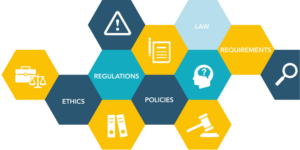
Nothing strikes fear into the heart of even the most steady in-house legal professional like the “s” word. That’s right, sanctions!
There’s no denying that litigation hold practices can open an organization up to risk, scrutiny, and unfortunate consequences. Most court sanctions result from flawed preservation processes that are rooted in the failure to identify all custodians, locate all data sources, or monitor compliance with a legal hold.
Some of the most critical yet most challenging steps in these processes are tracking custodians, the legal hold notices that have been issued, and the responses received from custodians. When custodians number into the hundreds or thousands, it can be difficult to determine whether they have responded to the initial hold, completed required questionnaires, or reconfirmed their compliance with subsequent hold reminders.
When companies still rely on manual methods, the legal team might not follow up with custodians once sending out an initial notice, opening their preservation strategy to the very scrutiny from opposing counsel or the court that everyone wants to avoid.
What Is an Audit Trail?
To show a defensible preservation process, legal teams need to have a record of all the activity and actions that were taken on a matter from the second litigation was anticipated until that matter is closed. Best practice is that the record, or audit trail, cannot be altered or changed in any way.
Common Methods of Creating Audit Trails
Tracking and reporting the status of the litigation hold process is an essential component in a defensible discovery program. Legal teams have a number of options for compiling this information.
Manual
Legal teams can use a spreadsheet to list custodians and track their responses. However, as the number of holds increases, these spreadsheets may become unwieldy.
Furthermore, organizations that keep individual spreadsheets by matter run the risk of neglecting the overlap between custodians and documents across matters. If they release a custodian from one hold, they may inadvertently affect another ongoing matter.
Manually tracking custodian compliance and ediscovery activities is riskier than using ediscovery software because manual records can easily be edited or erased. Courts know this, so if your company currently uses manual methods such as spreadsheets, be prepared to defend your process.
Email Read Receipts
Alternatively, organizations that use email to send initial and reminder legal hold notices can track whether custodians open the email by collecting return receipts. But, in addition to it being cumbersome to track hundreds or thousands of email receipts, this method does not require the custodians to affirmatively acknowledge their receipt; their passive act of simply opening the email, without more, sends a response.
In both cases above, manually compiling this information and following up with custodians can require a significant amount of time and staff effort, and are prone to human error.
Ediscovery Software
Legal hold software platforms help in-house legal teams save time and improve defensibility throughout the preservation process. For example, ZDiscovery’s audit trail removes the work of manual activity tracking and automatically records every single action into an unalterable and defensible report, saving a significant amount of time.
Elements of a Defensible Audit Trail
Strong audit trails are made up of a few layers:
The Who, What, Where, and When:
First, activities impacting custodians and data preservation/collection need to be logged, including the action that was taken, when, who the action impacted, and who took the action. For example, a strong audit trail for legal hold compliance needs to show who sent the legal hold, when, and to whom (custodian). The audit trail also needs to show when the custodian received the legal hold and the date when he or she agreed to comply with the instructions within the legal hold.
For data preservation and collection efforts, you need to be able to explain who made the request for data to be collected, what is the scope of the data (timeframe, sources, keywords, other parameters), who the request was sent to, who completed the preservation/collection, when, where the preserved/collected data lives now, and if there were any exceptions for data that could not be preserved or collected.
Reporting
Second, the logged information has to be accessible and able to be produced easily and quickly. The most efficient way to show an audit trail is through reporting. It is much easier to pull reports on-demand using ediscovery software, than spending hours manually analyzing, comparing, and compiling data into digestible reports. Most modern ediscovery legal hold software has the ability to pull reports showing legal hold compliance.
And while some software is better at it than others, if you’ve invested in a worthwhile ediscovery solution, there should be no need to use outside reporting tools. In ZDiscovery, users can pull over 40 different canned or customized reports showing legal hold and data preservation and collection on a scheduled or on-demand basis.
Defensibility Boosters
Third, if you want to ensure your legal hold audit trails are as rock solid as possible, it’s wise to utilize proactive defensibility boosters like reminders and periodic resending of legal holds. Reminders show a good faith effort to follow up with non-compliant custodians to make sure they’ve seen the legal hold notice and encourage them to comply. Reminders to custodians who have already accepted the legal hold simply serve to keep their data preservation obligations top of mind.
If your company experiences long litigation cycles (over one year), it’s a best practice to resend legal hold notices to custodians periodically and have them reconfirm they are still in compliance. Sending a legal hold multiple times does not negate the original sending and acceptance of the legal hold. Rather it builds on the audit trail and highlights the legal team’s effort to communicate with custodians and reduce the risk of spoliation.
How Zapproved’s Ediscovery Software Helps
ZDiscovery offers plenty of automation around highly time-consuming preservation tasks like custodian interviews, hold reminders, and, of course, the creation of a defensible audit trail and customizable reports.
With the audit trail automatically in place, legal teams can then run reports based on custodians and their acknowledgment status or reports based on the dates the holds were issued. The software can provide detailed hold histories that track each revision of the hold and list when custodians were notified of or released from a hold. Reports can also incorporate descriptions of any changes made to the legal hold notice over time.
If your current preservation process doesn’t offer an audit trail, upgrade to a better system for more peace of mind!




